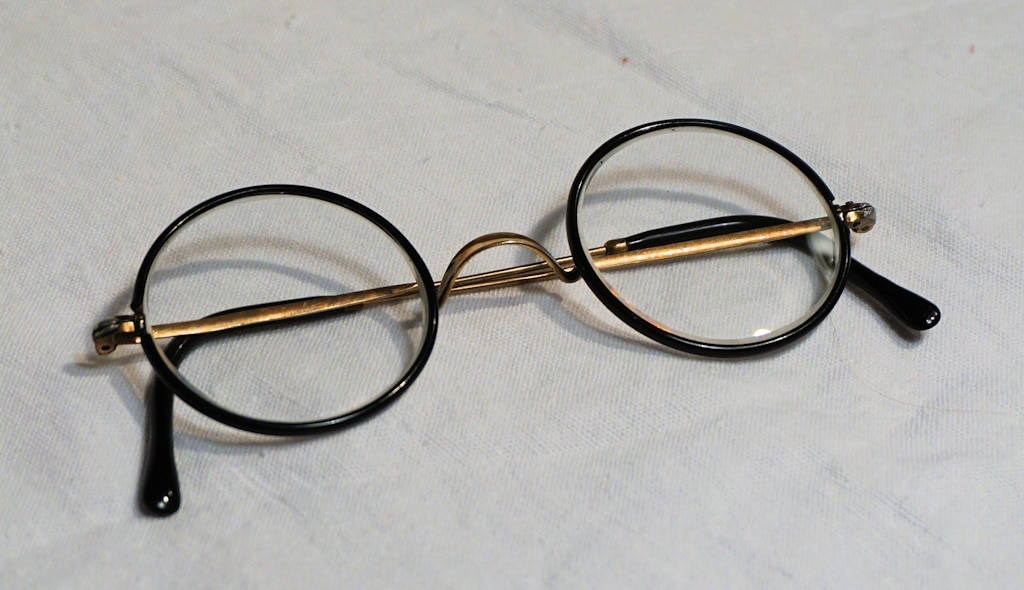Exactly when eyeglasses were invented is unclear. The history of the invention of glasses is often debated. Despite this, many agree that the very first pair were created in Italy during the 13th Century. Since then, the world has seen many innovations in eyewear. Today, glasses wearers are spoilt for choice. Millions of people across the globe wear glasses and there are so many different shapes and designs to choose from. Since spectacles were invented, they have become not just a necessity to correct vision but a very desirable and fashionable accessory to own. In this article, we will delve into some of the key milestones that contributed to the history of glasses.
Who invented glasses first?
A majority of sources agree that it is hard to pinpoint exactly who should be credited for glasses’ invention. The Romans were the first to recognise that it was possible to use glass to enhance their vision.
Later on, in the 9th Century, the multi-talented inventor and engineer Abbas ibn Firnas is believed to have created so-called reading stones which were essentially small pieces of glass polished and sculpted into a circular shape. They functioned as the earliest form of corrective lenses which could magnify text, making manuscripts easier to see and read.

13th Century – handheld and scissor glasses
The earliest glasses were simply two lenses made of glass connected together with a handle. The wearer would typically have to hold the glasses up in front of their eyes in order to see. They were commonly used by monks to read manuscripts. However, glasses started to gain more popularity among scholars at the time of the Renaissance.
Much like education at the time, only the wealthy had access to and could afford eyewear. Glasses were very quickly perceived as a symbol of affluence, intelligence and status in society. Vision testing was in its infancy at this time. Lenses were often very simple and came in different thicknesses.
Scissor glasses were also a very popular accessory to own at the time. These convenient glasses were designed with a hinge which meant they could be folded up and stored in your pocket. They were a real favourite of gentlemen who did not want to wear glasses all the time.
The lenses were made of glass or a crystal-like stone and were used to correct hyperopia (long-sightedness) and presbyopia. The frames and handle, meanwhile, were normally made of animal horn, leather, or wood.
14th Century – pince-nez glasses
It was around the 14th Century that pince-nez glasses emerged. This design meant glasses wearers could balance the lenses on their nose. However, these glasses were widely considered to be the most uncomfortable.
In fact, the translation of the French name ‘pince-nez’ means ‘pinch nose’ in English. These early glasses were designed to firmly grip onto the nose using the pressure of a spring to keep them on the face. Even so, the wearer would have to keep very still to make sure that they remained in the right place!
The issue was they were either too tight on the nose or slipped off the face. Wearers would often choose to connect them to their clothing with a chain or cord to prevent dropping them and causing damage.
Despite being widely acknowledged as the most uncomfortable style of glasses, a few centuries on and this design came back in fashion. It experienced a revival in the 1800s and was a style worn by many a famous face.

15th Century – a bigger demand for glasses
The printing press was invented by Johann Gutenberg in the 1400s which gave people access to reading materials. This in turn led to a greater requirement for vision correction. By the 1500s, glasses were being mass produced and sold by street merchants.
Sight tests were not yet in existence. Instead, glasses wearers would have to try on various pairs until they finally decided which one suited them best and with any luck, corrected their vision!
At this time, lenses for glasses were only recommended for older individuals. This is because eyesight tends to deteriorate with age and it becomes more difficult to see objects that are up close. However, we now know that many younger people also need lenses to correct their vision.
17th Century – concave lenses
German astronomer Johannes Kepler was the first to accurately describe how concave lenses could correct myopia (short-sightedness) compared to convex lenses for long-sightedness.
During the 17th Century, eyewear began to improve slightly. Trial lenses were put into a leather strap which could be tightened around the head, giving the wearer a better idea of their vision requirements. Also, various lens types could correct more vision issues.
18th Century – the invention of temples
In 1727, a very important part of glasses was invented – the temples (or the ‘arms’ as they are sometimes referred to). These are the parts at the side of your eyeglasses that link to the front of the frame via the hinges and sit on your ears. English optician Edward Scarlett was the first to invent temples for glasses. The temples were a huge breakthrough and provided the first example of glasses as we recognise them today. They were actually given their name because they could be secured onto the wearer’s temples and at this time, did not rest on the top of the ears as they often do now. The temples could also easily be disguised under a powered wig, which were highly fashionable at this period in time.

Bifocals are invented
Benjamin Franklin is credited for inventing bifocals at the end of the 18th Century. He was fed up with having to switch between different pairs of glasses for short and long distances so he created bifocals as a solution to the problem. Bifocal lenses were designed to be split into two separate viewing areas, one for distance and the other for near vision.
19th Century – corrective lenses for astigmatism
It was in 1801 that British polymath Thomas Young identified the irregular curvature of a cornea, recognised today as astigmatism. In fact, he diagnosed himself with the condition and by 1827, he had invented cylindrical lenses to correct his vision.
Sleeker frames and improved temples
In 1837, steel wire was available to create thinner, more lightweight metal frames. This steel meant straight temples could be added so the glasses rested comfortably over the ears.

20th Century and beyond – glasses enter the fashion world
Glasses developed massively in the 1900s as they became more widespread due to developments at the time. For example, First World War soldiers were provided with glasses and then in the late 1940s, the National Health Service offered free eyewear for those in need. As a result, many more people began to wear glasses and so this increased their production.
Sunglasses grew in popularity throughout the 20th Century as well. Despite the fact sunglasses were invented much earlier, most people did not become aware of them right away. In fact, they were first used by Chinese judges to disguise their facial expressions and mask their emotions during court trials.
Eyewear also became increasingly more fashionable, from the retro round frames of the 1920s to the feminine cat-eye glasses of the 1940s and 50s. Glasses became an even bigger fashion trend in the 1970s and 80s as style trends started to emerge and people sought more varied style options. Many more materials also became available, including versatile plastics that came in a variety of vibrant colours. Glasses could also be produced on a wider scale at a more affordable price.
Progressive lenses are launched
Progressive lenses, or varifocals, were first developed in the 1950s. The visible lines that separated the different viewing areas, as they did in bifocals, were removed for a clear, continuous view.
The future of eyewear
If we look back on how much glasses have developed throughout history so far, it is natural to think about the future. There is certainly a lot of hope and expectation for what’s to come.
In fact, there have been several innovations of late. EssilorLuxottica, in partnership with Meta, has launched Ray-Ban® Meta smart glasses which take pictures, live stream, play music and answer phone calls. Also, this year at the world-renowned tech convention, known as CES, EssilorLuxottica announced Nuance Audio, which are glasses with integrated hearing aids for people with mild to moderate hearing loss. This is a huge leap in technology and a fantastic solution for individuals struggling with both vision and hearing loss. These are just two examples of how technological advancements are helping eyewear to step into the future.
While we don’t have a crystal ball, we can make some predictions about what the future might look like for eyewear. As technology advances, there is set to be lots of big developments in the coming years. Glasses ranges are also likely to expand with funky new designs and colours to look forward to.




